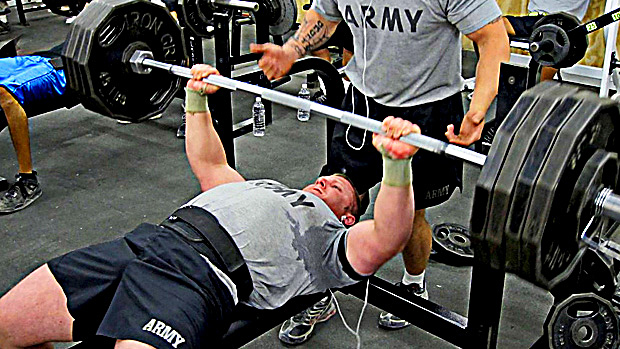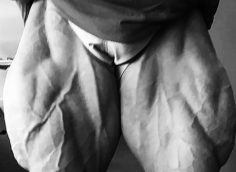Here's what you need to know...
- A lot of shoulder injuries result from raw (no bench shirt) lifters trying to emulate the style of geared lifters.
- Raw lifting and geared lifting are two different lifts and need to be treated as such.
- Using the ultra-wide grip used by geared lifters can lead to stagnation and possible injury.
- Optimizing your grip for a raw press will not only lead to a greater press, it'll keep you on the bench and off the therapy table.
- Simply measure the distance from the outside edge of both acromial processes. Then multiply by 1.5. This is how far apart your hands should be on the bar.
- At 1.5 times biacromial width, shoulders are placed at the ideal 45-degree angle of abduction.
Stop Copying Geared Lifters!
All iron athletes, be they bodybuilders or powerlifters, agree that performance is paramount and that the quickest way to decrease bench press performance and limit gains is a shoulder injury.
Where do those shoulder injuries come from? Often from raw (no bench shirt) lifters trying to emulate the style of geared lifters.

Raw lifters see the tucked chin and the ultra-wide grip that geared lifters use and assume that it's the way to go, when in reality it leads to stagnation and possible injury. However, optimizing your grip for a raw press will not only lead to a greater press, it'll keep you on the bench and off the therapy table.
If you set up wide while raw, it'll result in a loss of power. Setting up too narrow will develop some killer triceps but limit full muscle recruitment. Luckily, there's a simple, straightforward way of determining your proper grip. The answer lies in the golden number, 1.5.
Finding Your Biacromial Distance
Simply measure the distance from the outside edge of both acromial processes. Then multiply this number by 1.5. This is how far apart you should place your hands on the bar. Grip width is taken from the inside edge of your index finger on both sides.
In my case, the biacromial distance is 25.5 inches (17 inches x 1.5 = 25.5 inches):


Numbers Don't Lie
Hand position on the bench press directly correlates with external rotation of the shoulder. There are certain positions that cause excessive stress on your glenohumeral joint. When your arm is externally rotated and abducted 90° from your body, this is an "at risk" position for shoulder injury.
When gripping the bar with a distance of 2 times biacromial width or greater, the shoulder is forced to abduct over 75 degrees. However, at 1.5 or less, shoulders are placed at the ideal 45-degree angle of abduction.
Why ideal? EMG analysis has shown that it's the angle that allows the greatest amount of force to be transferred into the bar. A lot of geared lifters adopt the ultra-wide 2 times biacromial-width (or even more) grip to shorten the bar path and to get even more help from the shirt.
However, this isn't something a raw lifter should ever do. The shirt helps protect the lifter's shoulder whereas a raw lifter's tendons and ligaments have to fend for themselves.
You've got to accept that the geared lift is a different style of pressing and isn't suitable for a raw lift! Raw lifters attempting to mimic this style, even with a severe elbow tuck, are approaching the "at risk" position and its consequences.
Wide Grip Means Wide Chest?

The argument often gets made that a wider grip activates more pectoral muscles without decreasing triceps lockout strength. Unless you're in a shirt, this isn't the case.
Research has demonstrated in a one-rep max bench press test that there's no difference in the pectoralis muscle recruitment with a wide-bench press grip.
Additionally, research showed a large difference in the amount of triceps activation with the 1.5 biacromial distance grip, so not only is a wide grip an injury risk, but it's a performance reducer.
Raw lifting and geared lifting are two different lifts and need to be treated as such. Stealing hand and arm positions from geared lifters sets the stage for decreased performance and possible injury.
Final Recommendations
The potential for injury is far too high on the bench press. Grabbing the bar and pressing away in a bad position is killing your joints and your gains. Skip mimicking shirted movements and master your raw press. Find your biacromial distance and find your appropriate grip distance.
Now lower the bar with your forearms perpendicular to the floor and arm abducted 45° from your body. Maintain your upper back tightness and press the bar back up.
Press safely, maintain tightness, and use your grip, not someone else's.





